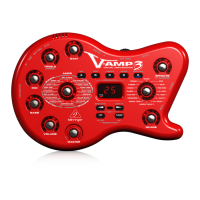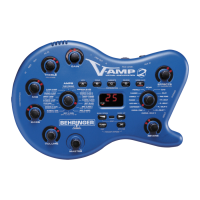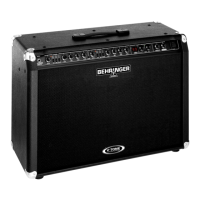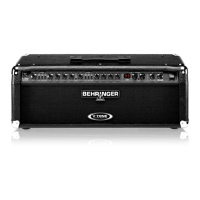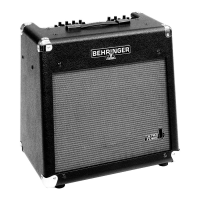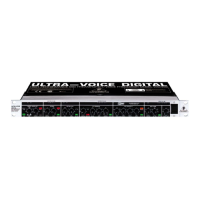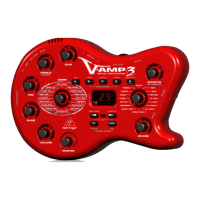11
V-AMP
2.3 Expanded set-up for studio and home recording applications
As a matter of fact, your V-AMP will be a perfect tool to record your guitar parts on tape or digital recorders. The
advantage is clear: Your V-AMP gives you utmost flexibility, as you can set it up in the control room of the
studio and dont need any loudspeaker, i.e. you have perfect control over your sound. Whenever you feel that
the guitar sound coming out of the recording console needs improvement, you can tell the audio engineer and
work with him to adjust the sound that fits into the recording. In a word: There is no need for bothersome
commuting between the recording and control room.
Fig. 2.3: Expanded set-up for studio and home recording applications
3. AMP/SPEAKER SIMULATION
This is an absolute highlight of your V-AMP: The simulation models can make your home recording work much
easier, because you dont need to mike your guitar amp. The V-AMP allows you to choose from one of those
legendary guitar amps, whether you play Brit Pop, Blues or Heavy Metal. Additionally, you can tailor each amp
and its sound to suit your personal ideals and connect it to one of 15 speaker cabinets. And to top it all, your
virtual amp even comes with a digital effect and reverb type. More on this in chapter 5 V-AMP PRESETS.
After power-up the V-AMP automatically loads the last preset selected. The LED ring around the AMPS
control shows which amp type has been selected. Simply turn the control to select another amp model. Then,
use the VOLUME, BASS, MID, TREBLE and GAIN controls to modify the basic sound. Typically, you will first
select an amplifier model, followed by a specific cabinet and effect. Chapter 5 describes how to store your
settings.
To get a clear overview of all amp simulations available, please read the following section that describes the
various amplifier models implemented in your V-AMP.
3.1 Description of amplifier models
AMERICAN BLUES: This amp has been modeled on a Fender Bassman 4 x 10 Combo. Originally designed as
a bass amp, the Fender Bassman soon became the standard amp of blues giants such as Steve Ray Vaughan
or Billy Gibbons, because of its unique distortion sound. As you would expect, it has lots of power in the bass
range but is still quite flexible in the mid and treble ranges.
MODERN CLASS A: This amplifier is characterized by its moderate distortion and almost hi-fi sound. It is
modeled on the Matchless Chieftain, a very expensive, hand-made amp.
TWEED COMBO: This was Jeff Becks favorite sound when he recorded Blow by Blow and Wired. Actually, the
Tweed Combo was not designed as a heavy-distortion amp, but with its small power stage it is ideally suited
to produce merciless overdrive sounds.
3. AMP/SPEAKER SIMULATION

